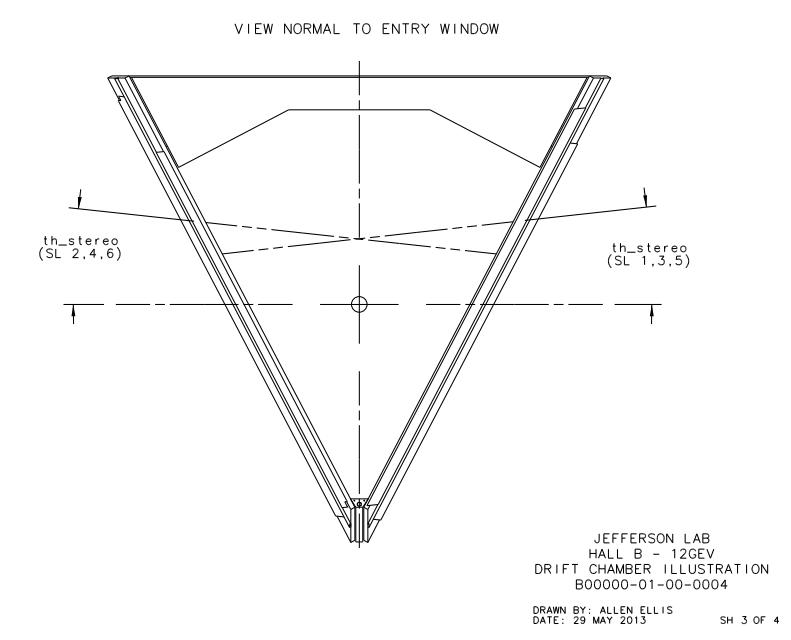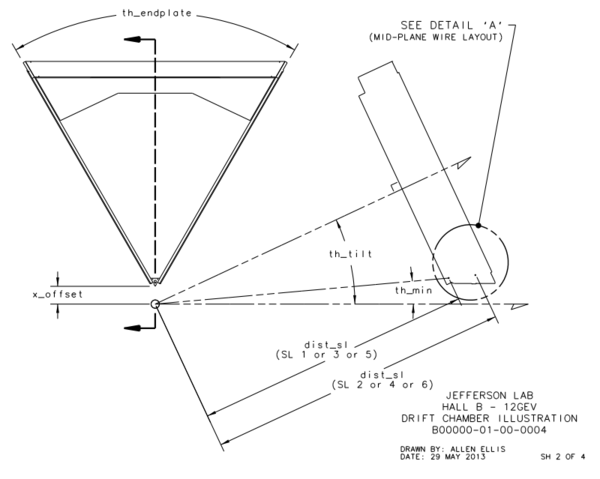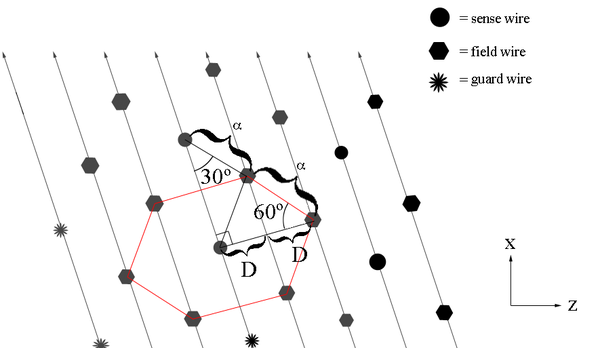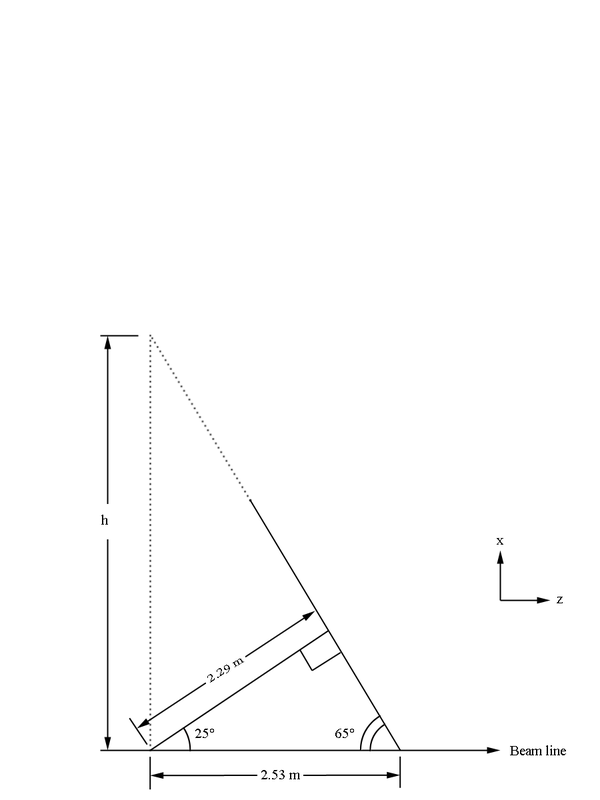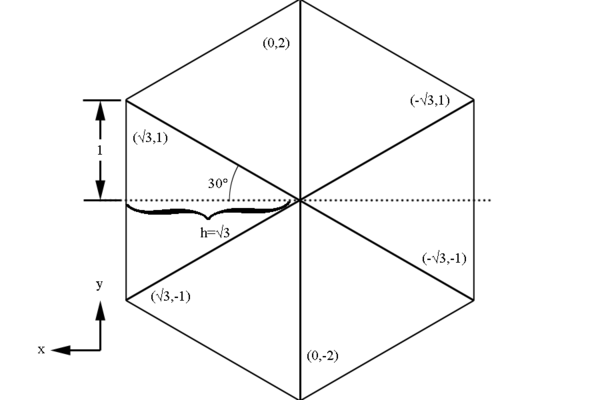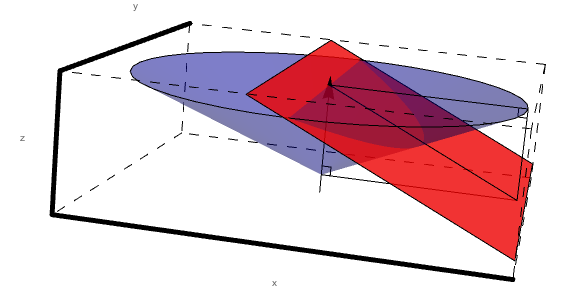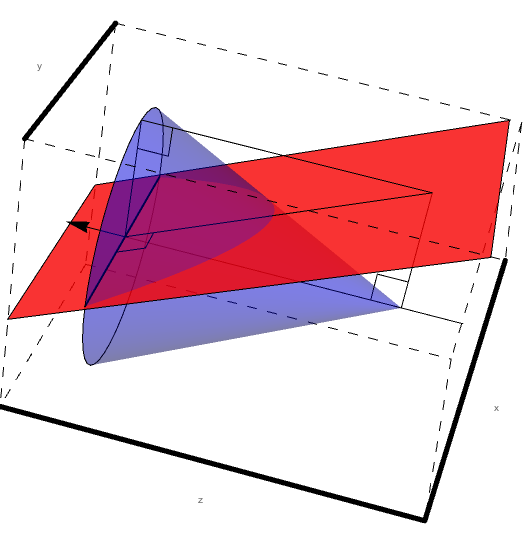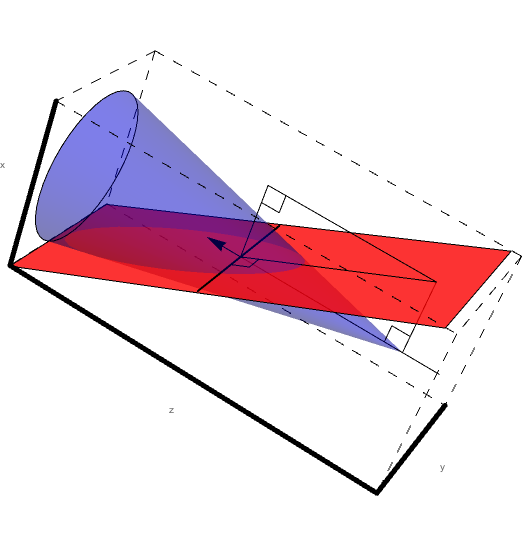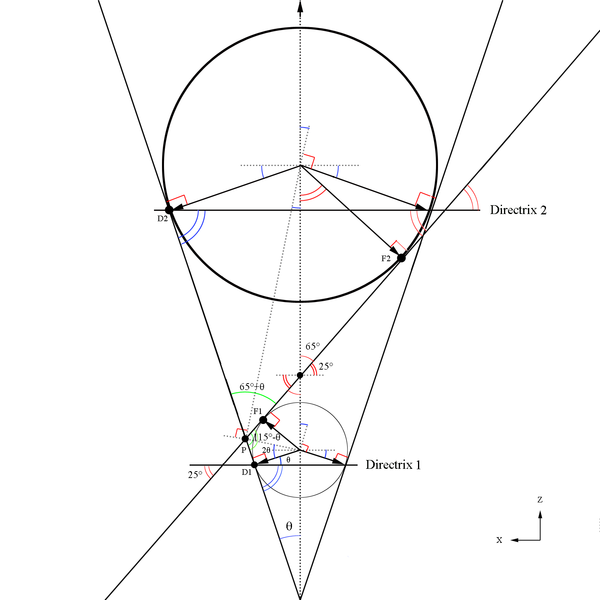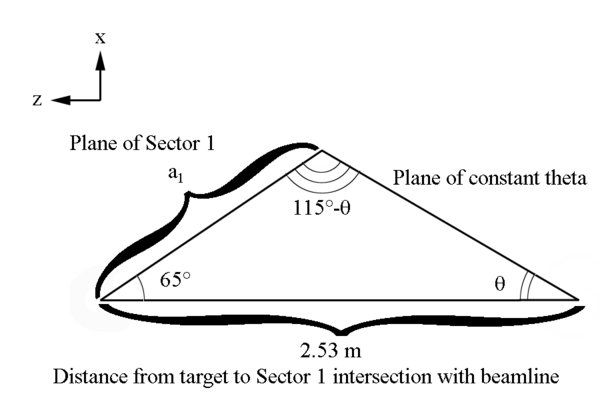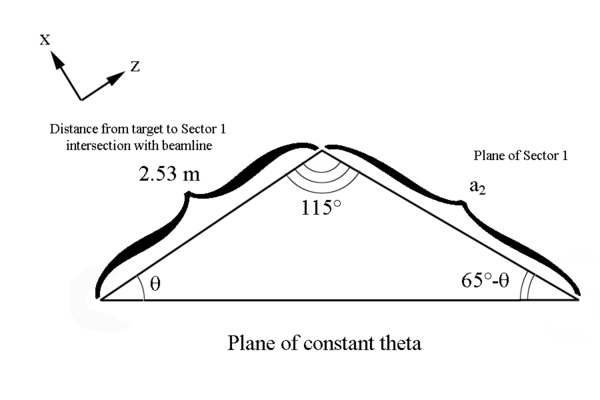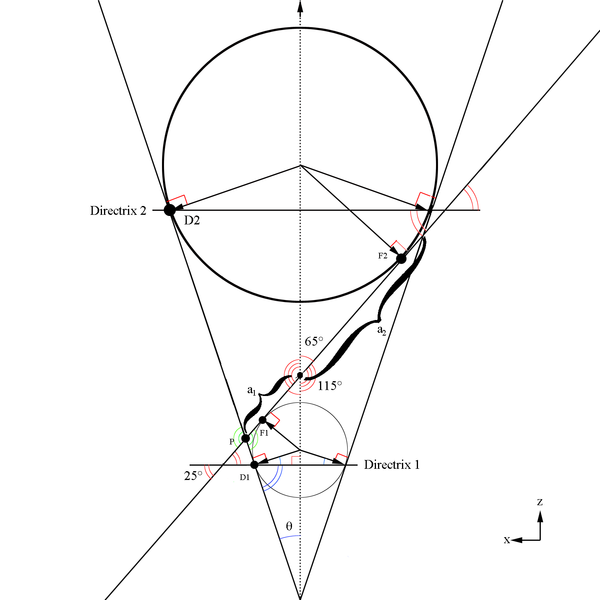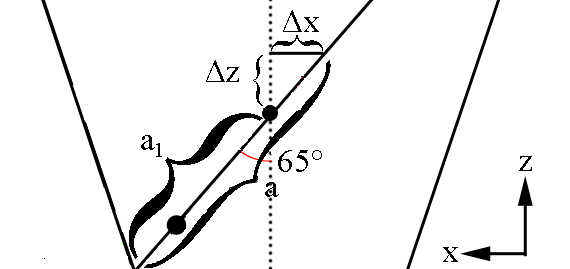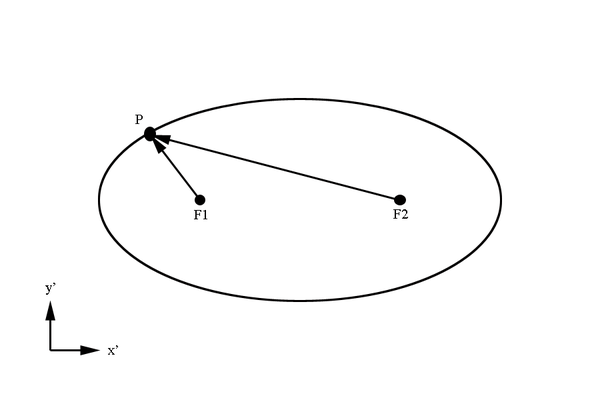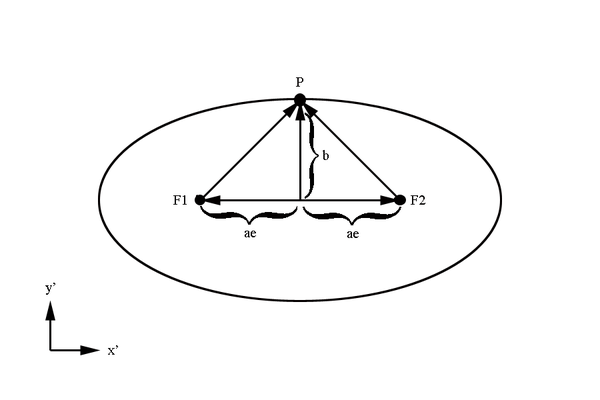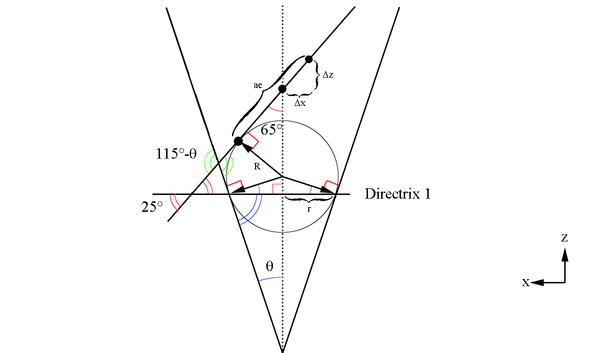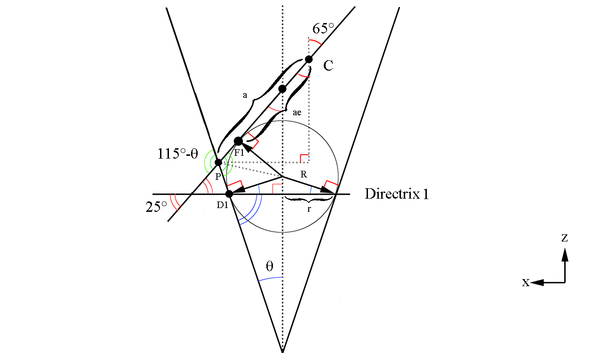Difference between revisions of "Determining wire-phi correspondance"
| Line 216: | Line 216: | ||
<center><math>\Delta x=\Delta a \cdot sin(25^{\circ})</math></center> | <center><math>\Delta x=\Delta a \cdot sin(25^{\circ})</math></center> | ||
| − | Since the vertex position is at (0\hat x,0\hat y,0\hat z) this shows the center of the ellipse to be at | + | Since the vertex position is at <math>(0\hat x,0\hat y,0\hat z)</math> this shows the center of the ellipse to be at |
Revision as of 16:23, 13 January 2017
Detector Geometry
Examining the geometry of the Drift Chamber, we can see that the detector is similar to a hexagonal pyramid in shape.
From the geometry it is given that xdist, the distance between the line of intersection of the two end-plate planes and the target position, is equal to 8.298 cm and th_min, the angle from the target vertex to the the same line, is 4.694 degrees. Using this knowledge we can simulate this situation by having the end-plate planes intersect at the beam line axis. This action in effect would grant the sector to measure angles below ~5 degrees, which we can account for by limiting angles theta within the accepted detector range. The quantity dist2tgt, the distance from the target to the first guard wire plane along the normal of said plane, is given as 228.078 cm. Using the previous understanding of the distances between planes within a Superlayer:
We know that the seperation between levels is a constant D=.3861 cm, and that sensor layer 1 is 3 layers deep.
This gives us the distance to level 1 from the vertex (0,0,0) as 228.078 cm+3(0.3861) cm=229.2363 cm in the positive z direction along the beam line. Using the fact that the wire planes are at 25 degrees to the beam line, we can approximate sector one as triangle that intersects with a line perpendicular to the beam line at the vertex position of (0,0,0) along the bisector of the triangle. While this is beyond the physical constructs of the experimental design, we do this mathematical simplicity. This again is acceptable in that angles beyond the physical limitations of 40 degrees will not be simulated. From the geometry of a hexagonal pyramid, we can see that the quantity h should be
Examining the geometry of a hexagonal of h= whose coordinates are easy to calculate:
We can scale this hexagon by a factor of .617 to find the base of the hexagonal pyramid simulating the drift chamber geometry.
sector1=Graphics3D[{Red,Opacity[.8],Polygon[{{0,0,2.29},{.617\[Sqrt]3,.617,0},{.617\[Sqrt]3,-.617,0}}]},BoxStyle->Dashing[{0.02,0.02}],Axes->True,AxesLabel->{"x","y","z"},Ticks->None,AxesStyle->Thickness[0.01]];
sector2=Graphics3D[{GrayLevel[0.5],Opacity[.2],Polygon[{{0,0,2.29},{.617\[Sqrt]3,-.617,0},{0,-2*.617,0}}]},BoxStyle->Dashing[{0.02,0.02}],Axes->True,AxesLabel->{"x","y","z"},Ticks->None,AxesStyle->Thickness[0.01]];
sector3=Graphics3D[{GrayLevel[0.5],Opacity[.2],Polygon[{{0,0,2.29},{0,-2*.617,0},{-.617\[Sqrt]3,-.617,0}}]},BoxStyle->Dashing[{0.02,0.02}],Axes->True,AxesLabel->{"x","y","z"},Ticks->None,AxesStyle->Thickness[0.01]];
sector4=Graphics3D[{GrayLevel[0.5],Opacity[.2],Polygon[{{0,0,2.29},{-.617\[Sqrt]3,-.617,0},{-.617\[Sqrt]3,.617,0}}]},BoxStyle->Dashing[{0.02,0.02}],Axes->True,AxesLabel->{"x","y","z"},Ticks->None,AxesStyle->Thickness[0.01]];
sector5=Graphics3D[{GrayLevel[0.5],Opacity[.2],Polygon[{{0,0,2.29},{-.617\[Sqrt]3,.617,0},{0,2*.617,0}}]},BoxStyle->Dashing[{0.02,0.02}],Axes->True,AxesLabel->{"x","y","z"},Ticks->None,AxesStyle->Thickness[0.01]];
sector6=Graphics3D[{GrayLevel[0.5],Opacity[.2],Polygon[{{0,0,2.29},{0,2*.617,0},{.617\[Sqrt]3,.617,0}}]},BoxStyle->Dashing[{0.02,0.02}],Axes->True,AxesLabel->{"x","y","z"},Ticks->None,AxesStyle->Thickness[0.01]];
Bisector0Sector1=Graphics3D[Line[{{0,0,2.29},{.617\[Sqrt]3,0,0}}]];
Bisector0perpSector1=Graphics3D[Line[{{0,0,0},{.617\[Sqrt]3,0,0}}]];
RightAngleVertical=Graphics3D[Line[{{.25,0,.25},{.25,0,0}}]];
RightAngleHorizontal=Graphics3D[Line[{{.25,0,.25},{0,0,.25}}]];
Bisector0Cone=Graphics3D[Line[{{.617\[Sqrt]3,0,0},{.617\[Sqrt]3,0,2.29}}]];
Bisector0perpCone=Graphics3D[Line[{{0,0,2.29},{.617\[Sqrt]3,0,2.29}}]];
RightAngleVertical2=Graphics3D[Line[{{.617\[Sqrt]3-.25,0,2.29-.25},{.617\[Sqrt]3-.25,0,2.29}}]];
RightAngleHorizontal2=Graphics3D[Line[{{.617\[Sqrt]3-.25,0,2.29-.25},{.617\[Sqrt]3,0,2.29-.25}}]];
BeamLine=Graphics3D[Arrow[{{0,0,-.5},{0,0,2.79}}]];
PhiCone=Graphics3D[{Blue,Opacity[.3],Cone[{{0,0,2.29},{0,0,0}},.617\[Sqrt]3]},BoxStyle->Dashing[{0.02,0.02}],Axes->True,AxesLabel->{"x","y","z"},Ticks->None,AxesStyle->Thickness[0.01]];
Viewing the simulation,
Show[sector1,sector2,sector3,sector4,sector5,sector6,PhiCone,BeamLine,Bisector0Sector1,Bisector0perpSector1,Bisector0Cone,Bisector0perpCone,RightAngleVertical,RightAngleHorizontal,RightAngleVertical2,RightAngleHorizontal2]
When the scattering angle theta, which is measured with respect to the beam line, is held constant and rotated through 360 degrees in phi, a cone is created. Using Mathematica, we can produce a 3D rendering of how the sectors for Level 1 would have to interact with a steady angle theta with respect to the beam line, as angle phi is rotated through 360 degrees.
Conic Sections
Looking just at sector 1, we can see that the intersection of level 1 and the cone of constant angle theta forms a conic section.
Show[sector1,PhiCone,BeamLine,Bisector0Sector1,Bisector0perpSector1,Bisector0Cone,Bisector0perpCone,RightAngleVertical,RightAngleHorizontal,RightAngleVertical2,RightAngleHorizontal2]
Without loss of generalization, we can extend the triangle to an infinite plane to aid in viewing the conic section. Again, this falls outside of the experimental design range, but simulations would not occur in this forbidden zone.
sector1plane =
Graphics3D[{Red, Opacity[.8],
InfinitePlane[{{0, 0, 2.29}, {.617 \[Sqrt]3, .617,
0}, {.617 \[Sqrt]3, -.617, 0}}]},
BoxStyle -> Dashing[{0.02, 0.02}], Axes -> True,
AxesLabel -> {"x", "y", "z"}, Ticks -> None,
AxesStyle -> Thickness[0.01]];
Following the rules of conic sections we know that the eccentricity of the conic is given by:
where β is the angle between the plane and the horizontal and α is the angle between the cone's slant generator and the horizontal.
Examining the different conic sections possible we know that:
Circular Conic Section
If the conic is an circle, e=0. This implies
Using the identity
The sector angle will never be perpendicular to the plane of the light cone, so this is not a physical possibility.
Elliptic Conic Section
If the conic is an ellipse, 0<e<1. This implies
Using the identity
since e must be less than 1, this sets the limit of theta at less than 25 degrees. Similarly, since the limit of theta observed is 0 degrees, this sets the lower limit for the eccentricity
This implies that the shape made on the the plane of the sector is an ellipse for angles
Determining ellipse components
Here we must take note of the fact that the center of the cone and the center of the ellipse do not coincide as can be shown visually by extending the cone length.
Here we will make use of Dandelin spheres to help determine the ellipse components with reference to the cone created at a constant theta. The basic construction of using Dandelin spheres is that within the cone, there are two spheres which are tangent to the plane as well as tangent to the cone as shown below in the xz plane. The Dandelin method picks an arbitrary point,P, on the intersection of the cone and the ellipse's plane. Drawing a line from the cone vertex through the point P, the directrix lines are intersected as shown below at D1 and D2. From the geometry as shown in the xz plane, it is shown that the line segments F1P=D1P and F2P=D2P since they share a common line segment, all three angles, and both have a the respective Dandelin radius as parts of the triangles they form.
We can use the law of sines to find a portion of the ellipse
Since these lines meet at the intersection of each other, and they both originate at the vertex positions for the ellipse, we can state that the semi major axis is:
Using the fact that half the semi-major axis will give use the center of the ellipse
Earlier, using the law of sines it was found:
Taking the difference
Since the vertex position is at this shows the center of the ellipse to be at
The sum of the distance from both focal points to a point on the surface of the ellipse is a constant
A property of an ellipse is that the distance from the center of the ellipse to a focal point is given by
Additionally, using the fact that the distance from the center to a focal point is ae
By symmetry,
Determining Elliptical Equation
As found earlier
Given the center point coordinates found earlier:
This gives the location of P() at
The height in z can be viewed as a linear function of x and expressed in slope intercept form for a plane:
where
The D1 and D2 components can be obtained by finding the x and y components of the two directrix circles, which will be a function of their respective radii and the angle phi around the z axis.
Similarly,
Test for Theta and Phi
Solving for
The height to the first directrix circle is
The height to the second directrix circle is
The distance between the two point
This should be equal to 2a
Using the fact that
From the view point of the cone vertex looking down the beamline, the upper and lower directrix, as well as the ellipse at 25 degrees from the horizontal, appear as circles. The directrix circles share a center with the beamline/ cone vertex, while the ellipse's center is offset. This shows that if an angular measurement as in a rotation of phi were to occur, the circles and ellipse would not mark out the same angle.
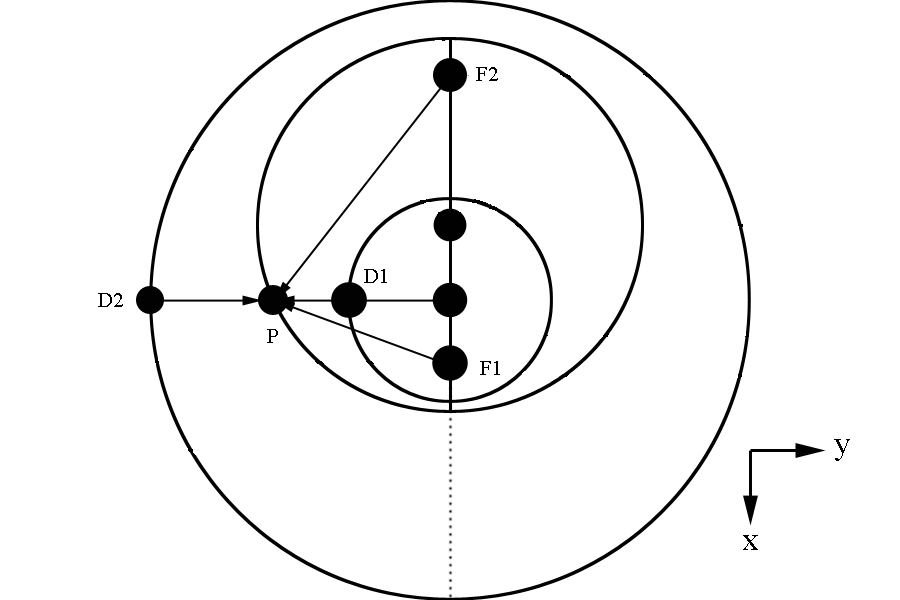
Using the properties of an ellipse, we can work in the coordinates of the ellipse where the center of the ellipse is at x'=0 and y'=0. The y and y' are equal, so for simplicity they are simply denoted as y.
where
For ellipses centered at (h,k) in parallel to the beamline:
Substituting the parametric representation for x and y
As discussed earlier, taking the 1st derivative of this function will give us the spacing of the bins as a function of wire number.
Parabolic Conic Section
If the conic is an parabola, e=1
This implies
Using the identity
For a parabola:
where
p = distance from vertex to focus (or directrix)
Hyperbolic Conic Section
If the conic is an hyperbola, e>1
This implies
Using the identity
Additionally, since the dector has an upward limit of 40 degres this implies that
